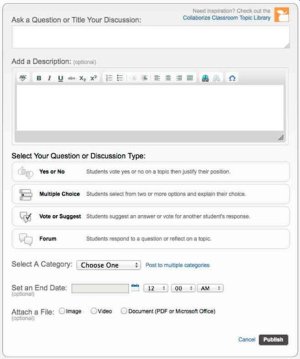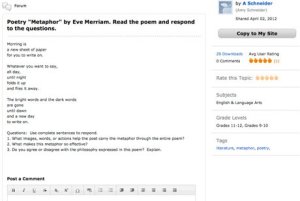Tips for Augmenting Whole-Class Discussions with Collaborize
Your content has been saved!
Go to My Saved Content.Technology can enhance academic conversations, says Anna Des Roches, a community development officer for Collaborize Classroom. The American Association of School Librarians (AALS) agrees, naming Collaborize one of the "Top 25 Best Websites for Teaching and Learning in 2012."
Blake Wiggs, a history and language arts teacher in North Carolina, often uses Collaborize to efficiently "organize classroom participants and sort their contribution to the discussion." He likes that he can integrate audio or video clips and widgets into the discussion pages. Nico Saldana, a high school world history teacher, uses Collaborize to increase student participation: "Nobody can check out of a conversation because everyone is writing."
Collaborize: The Basics
The free online Collaborize Classroom platform allows teachers to create password-protected multi-media discussion prompts in a couple minutes and has iPad and iPhone apps available. Students are encouraged to use the tool during or after class to extend Socratic dialogues, post their own questions or create surveys.
Four types of discussions are available with Collaborize: Yes/No, Multiple Choice, Vote or Suggest and Forum. Students can see the published results and continue discussions or post subsequent prompts.

Specific questions can be assigned to small groups within classes to differentiate instruction. Collaborize provides a discussion rubric that directs students towards meaningful responses to peers' comments.
Included within the Collaborize site is a database called Classroom Topic Library, which contains lessons searchable by grade level, content and Common Core State Standards. Clicking a button assigns and adapts multimedia topics to any of your classes.

The tools and online discussion models on the Collaborize site deconstruct the traditional elements of academic discourse: combining elements, upending traditional roles, changing their forms and functions, and putting them back together in ways that engage students. For example, why not have students use multiple choice tests to provide feedback on key aspects of peer essays and have the results instantly aggregated?
Collaborize Classroom facilitator Catlin Tucker is an English instructor at Sonoma County's Windsor High School and author of Blended Learning in Grades 4-12: Leveraging the Power of Technology to Create Student-Centered Classrooms. Her Topic Library contributions demonstrate her creativity in rethinking traditional conversations. "I evolved from asking analytical questions about literature," says Tucker, "to using my learning platform to support collaborative group work, creative writing, peer editing, student-driven projects and standardized test practice. As a result, I feel more empowered."
But What Can You Actually Do with Collaborize?
Some teachers use the platform for literature study groups and WebQuests. Collaborize acts as an online portfolio. Below are some other Collaborize Classroom activities, many of which I've pulled from Catlin Tucker’s strategy-rich book.
Teachers can use Collaborize Classroom to . . .
- It seems like a majority of the class agreed that ______. Argue the other side.
- Brainstorm with a peer: Why did ______?
- What would have happened if ______?
- Paraphrase what [name of peer] said, and then add support to make her/his argument even better.
- Examine the results of an online poll and hypothesize why your classmates voted as they did.
- Make connections between the discussions taking place and information learned in other classes and subject areas.
- Building on Lawrence's assertion that _____, I think _____.
- How did you know that ______?
- Convince us that ______.
After teaching about introductory paragraph hooks, Tucker's students fire up Collaborize and respond to three peer-written introductions, highlighting strengths, suggestions for improvement, unclear wording, etc. Novice writers are given a chance to revise before submitting their final drafts to her, which inevitably have improved.
Catlin Tucker is a master of activities that reduce her paper-load but do not sacrifice valuable opportunities to learn. Many of these activities can be found in her recorded webinars.